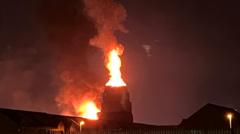Is Lighting a Bonfire Safe Despite Asbestos Worries?

Understanding the Risks of Bonfire Celebrations in Northern Ireland: A Case Study
In recent discussions around community celebrations in Northern Ireland, a significant incident has brought to light the dangers associated with bonfires, particularly when hazardous materials like asbestos are involved. The situation surrounding a bonfire in south Belfast has raised numerous concerns about public safety and environmental responsibility. This article delves into the details of the incident, the responses from various stakeholders, and the broader implications for community celebrations and safety regulations.
The Background of Bonfire Celebrations
Bonfires have long been a tradition in Northern Ireland, particularly during the Eleventh night celebrations, which precede the Twelfth of July. This date commemorates the Battle of the Boyne, a significant event in Protestant history. These celebrations often involve lighting large bonfires, which can be a source of community pride and unity. However, this long-standing tradition also comes with responsibilities regarding safety and environmental health.
The Incident in Question
On a recent Eleventh night, a bonfire was set alight in south Belfast, despite warnings from the Northern Ireland Environment Minister, Andrew Muir, regarding the presence of asbestos at the site. The bonfire was located near an electricity substation, raising further concerns about public safety and the potential impact on nearby hospitals.
Muir emphasized the importance of exercising caution, stating, “There are many ways to celebrate but not at this site.” His comments reflect a growing concern among officials regarding the intersection of tradition and safety.
Asbestos: A Hidden Danger
Asbestos is a known carcinogen, and exposure can lead to serious health issues, including lung cancer and mesothelioma. The presence of asbestos at the bonfire site had been acknowledged by the Northern Ireland Environment Agency (NIEA), which reported the removal of approximately 20kg of asbestos. Despite this, further fragments were discovered, highlighting the ongoing risks associated with the site.
The NIEA's initial alert to the issues surrounding this bonfire came as early as May, yet they stated that circumstances did not allow for a safe and controlled removal of the hazardous materials prior to the celebrations. This delay in addressing the asbestos issue raises questions about the effectiveness of communication and risk management by environmental agencies.
The Political Fallout
The incident quickly became a political hot potato, with various parties engaging in blame-shifting. Muir accused opposition parties of "finger-pointing," suggesting that they were not taking the matter seriously. The grand secretary of the Orange Order, Rev Mervyn Gibson, argued that if asbestos was a significant concern, the NIEA should have acted months earlier, as bonfire builders had been on-site since January.
This exchange emphasizes the complexities of addressing public safety within a politically charged environment where cultural traditions are deeply rooted in community identity.
Community Responses and Concerns
Former Progressive Unionist Party (PUP) leader Brian Ervine expressed his concerns about lighting the bonfire, emphasizing that the community must be prepared for the consequences if it occurs. His comments underscore the need for a balance between cultural expression and public safety.
Sinn Féin assembly member Pat Sheehan echoed these sentiments, calling for a thorough assessment of the asbestos risks and stating that "serious public safety concerns remain." This call for a factual assessment illustrates the need for transparency and accountability in addressing environmental hazards.
Challenges in Management and Mitigation
The police confirmed that they would not assist in dismantling the bonfire, citing that the risks associated with the bonfire proceeding were lower than those involved in attempting to dismantle it. This decision highlights the complexities of managing public safety in the context of community celebrations.
Furthermore, Belfast City Council's involvement in the situation has been multifaceted. While the council voted to request the removal of asbestos, they also faced criticism for their response time and the adequacy of their safety measures. The NIEA’s role in this situation also came under scrutiny, with local leaders questioning why more wasn't done earlier.
Health Implications and Expert Opinions
Health professionals, including Dr. Alan Stout, a GP and chair of the BMA NI Council, expressed their astonishment at the potential exposure of the public to asbestos at the site. Dr. Stout emphasized that any environment containing asbestos should be secured and monitored to prevent public exposure. His comments highlight the urgency of addressing health risks associated with hazardous materials in community spaces.
The Role of Landowners in Safety
The landowners, Boron Developments, purchased the site in 2017 and were reportedly aware of the asbestos issue. They engaged a waste management company to remove the hazardous material but faced challenges due to ongoing construction at the site by bonfire builders. This situation raises questions about landowner responsibilities in ensuring safety and compliance with environmental regulations.
Moving Forward: Lessons Learned
The incident surrounding the bonfire in south Belfast serves as a stark reminder of the need for better risk management and communication when it comes to public safety and environmental health. As communities continue to celebrate their traditions, it is crucial to prioritize safety alongside cultural expression.
Key Takeaways
- Bonfires are an integral part of cultural celebrations in Northern Ireland, but they pose significant health risks when hazardous materials are present.
- Effective communication and timely action from environmental agencies are essential in addressing public safety concerns.
- Community leaders and landowners must work collaboratively to ensure the safety of all participants in celebrations.
- Public health experts emphasize the importance of securing hazardous sites to prevent exposure to dangerous materials.
FAQs
What risks are associated with bonfires containing asbestos?
Bonfires containing asbestos pose serious health risks, including exposure to carcinogenic materials, which can lead to lung diseases and cancers.
What should be done if asbestos is found at a bonfire site?
If asbestos is discovered at a bonfire site, it should be secured, and removal should be handled by qualified professionals to ensure public safety.
How can communities celebrate safely while respecting traditions?
Communities can celebrate safely by conducting thorough risk assessments, ensuring compliance with safety regulations, and engaging with health experts to mitigate potential hazards.
What role do local authorities play in managing bonfire celebrations?
Local authorities are responsible for overseeing public safety, managing environmental risks, and facilitating communication among community leaders to ensure safe celebrations.
The recent events surrounding the bonfire in south Belfast highlight the critical intersection of tradition, public safety, and environmental responsibility. As communities navigate these complex issues, the importance of proactive measures cannot be overstated. How can we ensure that cultural celebrations continue without compromising public health? #BonfireSafety #PublicHealth #CommunityTraditions
Published: 2025-07-12 05:49:27 | Category: technology



